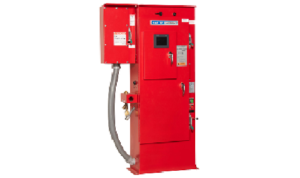Future Safety Features in Fire Pump Controllers – Master Controls
November 16, 2020We are often interested in directing industry attention to important future advancements in fire protection. Today’s topic pertains to new safety features that include an effective and creative solution to minimizing the dangers of arc flash in fire pump controllers. For the purposes of this article, we will be discussing electric fire pump controllers.
Fire pump controllers are required by NFPA 20 and NEC Article 695, and have strict rules regarding the connection of electrical power to the fire pump controller. The reason for this is that code officials are concerned about an inadvertent disconnection of electrical power in the event of a fire, which would obviously prevent an electric motor-driven fire pump from operating. So, the preferred method of electrical connection is the simplest — a direct connection from the utility power to the fire pump controller. Even if some disconnect switches and overcurrent protective devices are used, their size, location, lettering, etc. are clearly spelled out in NEC and NFPA 20.
Fire pump controllers are constantly energized (connected to power) and ready to be called into action. And as just mentioned, the controllers are often more directly connected to incoming utility power than other motor loads within a building. These characteristics of fire pump controllers bring with it additional risks of arc flash — the extremely dangerous situation where the electric current leaves its intended path and instead travels from one conductor to another or to ground. Depending on the source of power, several hundreds of thousands of amps can rush into the controller and instantly melt metal, wires, and anything in its path. It is, more or less lightning, and it can be fatal to anyone nearby.
Personal Protective Equipment (PPE) required for electrical work (NFPA 70E) is available in the market today, but they may not be sufficient when dealing with fire pump controllers, since by code they are often connected virtually to an unlimited energy source. Many institutions today are mandating therefore that no energized work is permitted due to this danger.
Historically this has meant that you will need to disconnect power to the entire building before performing any maintenance on fire pump controllers. (Remember, fire pump controllers have a dedicated power source to prevent being inadvertently disconnected). Besides being disruptive and inconvenient, shutting off all power often makes troubleshooting a fire pump controller impossible. So… how can we safely troubleshoot a fire pump controller without the hassle of shutting down the entire building’s electrical power?
Master Controls (www.mastercontrols.com) has invented a creative way to help reduce the risk of arc flash in fire pump controllers by placing the isolation switch in its own separate enclosure, where it can still be attached to the main controller (see picture) and act as an isolating switch, but also act as a circuit breaker to provide additional protection. This feature keeps all of the requirements placed on controllers by NFPA 20 intact but in a much more “arc flash friendly” way. Master Controls calls this option “SIS” (separately isolated switch). Not only does this make servicing a live controller safer, but it allows the controller to be labeled with an incident energy calorie rating not exceeding 0.5 cal/cm2 — something standard controllers have never been able to do.
I believe this feature is the future of safe fire pump controller construction, especially for large universities, hospitals, and institutional locations where safety protocols are organized and governed more closely.
Please check out a fantastic video of this feature in action below, and get more information at www.mastercontrols.com
